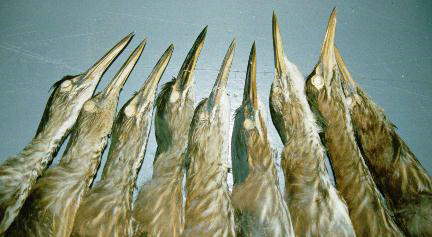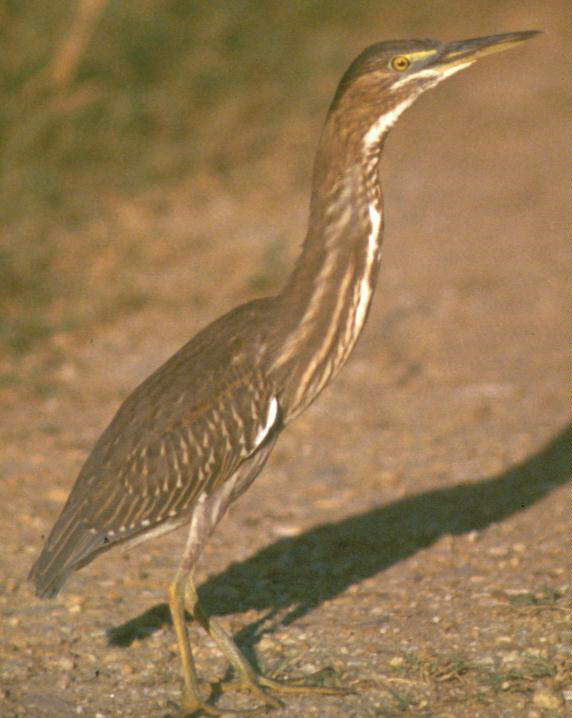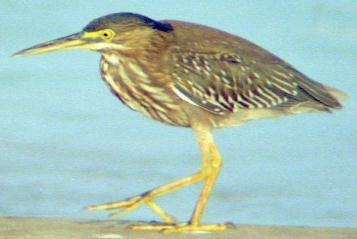| SOUTHEASTERN CARIBBEAN BIRDS PHOTO GALLERY |
| Trinidad and Tobago Field Naturalists' Club Southeastern Caribbean Bird Alert Trinidad and Tobago Rare Bird Committee |
| IDENTIFICATION ESSAY |
| Green Heron (Butorides virescens) and Striated Heron (B. striatus): Page 1 of 2 Immatures Adults |
|
The rufous-necked Green Heron is resident in North
America, Central America and throughout the Caribbean, with
northernmost populations wintering as far south as northern South
America. The Striated Heron occurs throughout South America, where it
is relatively sedentary, as well as the Old World. The two forms meet
in southern Central America, islands of the southern Caribbean, and in
coastal northern South America, where hybridization occurs as inferred
by increased intermediacy and variability (Payne 1974, Hayes 2002).
Because seemingly pure phenotypes occur within the hybrid zone,
implying assortative rather than randon mating, the two taxa are
probably best regarded as specifically distinct, although more study is
needed (Hayes 2002). In the southeastern Caribbean, the Lesser Antilles and Tobago are inhabited by the Green Heron whereas the Striated Heron occurs in Trinidad and the adjacent mainland. The Striated Heron may be expected to wander northward; the only Lesser Antillean records are a specimen from St. Vincent (click here) and a recent record from the Virgin Islands (click here). The Green Heron occurs rarely in Trinidad, presumably as a migrant from North America or perhaps from Tobago. In Tobago, the population is composed predominantly of Green Heron with a small proportion of Striated Heron and intermediate individuals. In a comprehensive study of geographic variation within the New World, Payne (1974) used a series of nine voucher specimens as a hybrid index to score neck coloration in adults (see Fig. 4 in page 2). Photographs of these specimens can be used to score live individuals in the field (Hayes in prep.). Given the frequent occurrence of intermediate phenotypes in the southeastern Caribbean and the confusion regarding their identity, the variability of these taxa is discussed in this photo essay. Juveniles and immatures.--Juveniles and immatures of both species are readily distinguished from adults by their heavy streaking on the brownish neck and upper breast, a brownish cast to the upperparts, a pale triangular spot at the tip of each covert and remige, and a whitish belly. Immatures have a more solid, black crown, whiter chin and throat, and lighter streaking on the neck than juveniles. The thighs may be barred and the bill is usually paler than in adults. Distinguishing between the two taxa at this age is extremely difficult. The only apparent distinction is neck colouration, in which Green Heron tends to be more rufous and Striated Heron tends to be more grey, but there is considerable overlap. Observers should be careful not to mistake brown-necked juvenile and immature Striated Heron for adult Green Heron. Subadults.--First-alternate (first-summer) birds resemble adults but retain pale-tipped juvenal wing feathers and have shorter back plumes. Adult neck colouration is aquired, being solid except for a pale malar stripe and a narrow pale line with rufous streaking on the foreneck. The two taxa are usually distinguished by neck coloration, which is more rufous in Green Heron and greyer in Striated Heron. However, considerable variation occurs and intermediate individuals may represent hybrids. Adults.--Adults are readily distinguished from immatures by their darker bill, solid colouration on the sides of the neck, greenish-grey upperparts lacking brown lones, longer back plumes, more pointed scapulars and wing coverts, narrower buffy margins to the wing coverts (which lack white spots), narrower white tips of flight feathers restricted to the inner primaries and secondaries, and darker brown-gray underparts. The only apparent distinction between the two taxa is neck coloration, which is more rufous in Green Heron and greyer in Striated Heron. Considerable variation occurs, with neck coloration ranging from grey to brownish grey in Striated Heron throughout its range, and from grayish red-brown to dark purplish brown in the Green Heron. Intermediate appearing individuals in the southeastern Caribbean may represent hybrids and obviously cannot be identified. Hindneck coloration of adults often provides the best clue for identification. In Green Heron, the hindneck is always rufous without any hint of grey, except when feathers are ruffled or moulting, revealing the grey bases of adjacent feathers. In browner-necked Striated Herons, the brown is usually (though not always) more intense toward the front of the neck, where it merges with the rufous streaking, and is often greyer on the hindneck. LITERATURE CITED Hayes, F. E. 2002. Geographic variation, hybridization, and taxonomy of New World Butorides herons. North American Birds 56:4-10. Payne, R. B. 1974. Species limits and variation of the New World Green Herons Butorides virescens and Striated Herons B. striatus. Bulletin of the British Ornithologists' Club 94:81-88. |
| Fig. 1. Juvenile or immature specimens (from the American Museum of Natural History) of Striated Heron (four individuals at left, from Brazil) and Green Heron (five individuals at right, from North America and Central America). Although these specimens illustrate the relatively greyer neck coloration of Striated Heron, overlap occurs among specimens. Photo © by Floyd Hayes, published in Hayes (2002). |
 |
 |
 |
| Fig. 2. Presumed immature Green Heron at Bon Accord Sewage Ponds, Tobago, 7 August 2002. Note the heavy streaking on the neck, brownish cast to the upperparts, pale-tipped wing feathers and whitish belly, which distinguish this individual from an adult. Although most Butorides in Tobago are Green Herons, the frequent occurrence of relatively pure Striated Heron and intermediate phenotypes indicates that the identity of this individual cannot be ascertained with certainty. Photo © by Floyd Hayes. |
| Fig. 3. Presumed immature Striated Heron at Caroni Rice Fields, Trinidad, 16 September 2000. The greyish tones on the neck are suggestive of Striated Heron, but identification cannot be certain. Photo © by Floyd Hayes. |